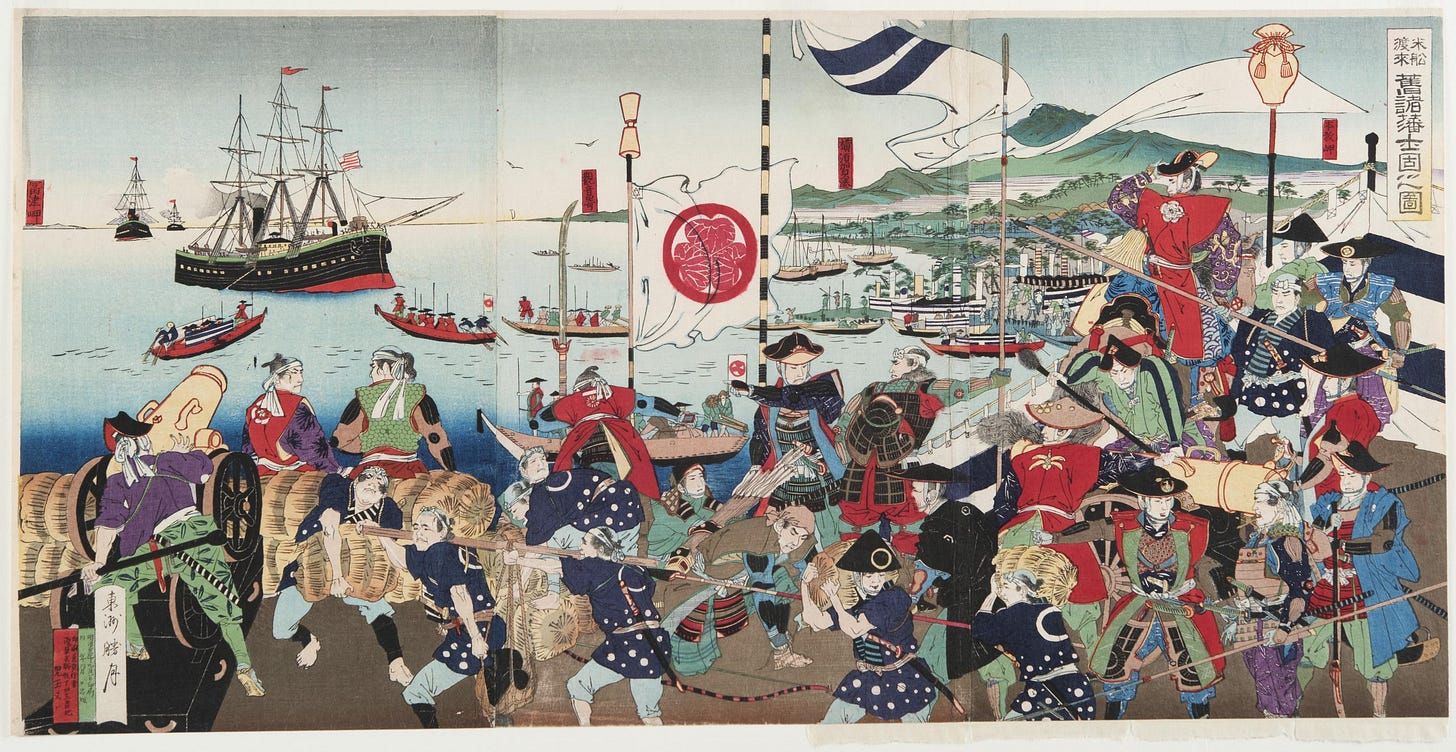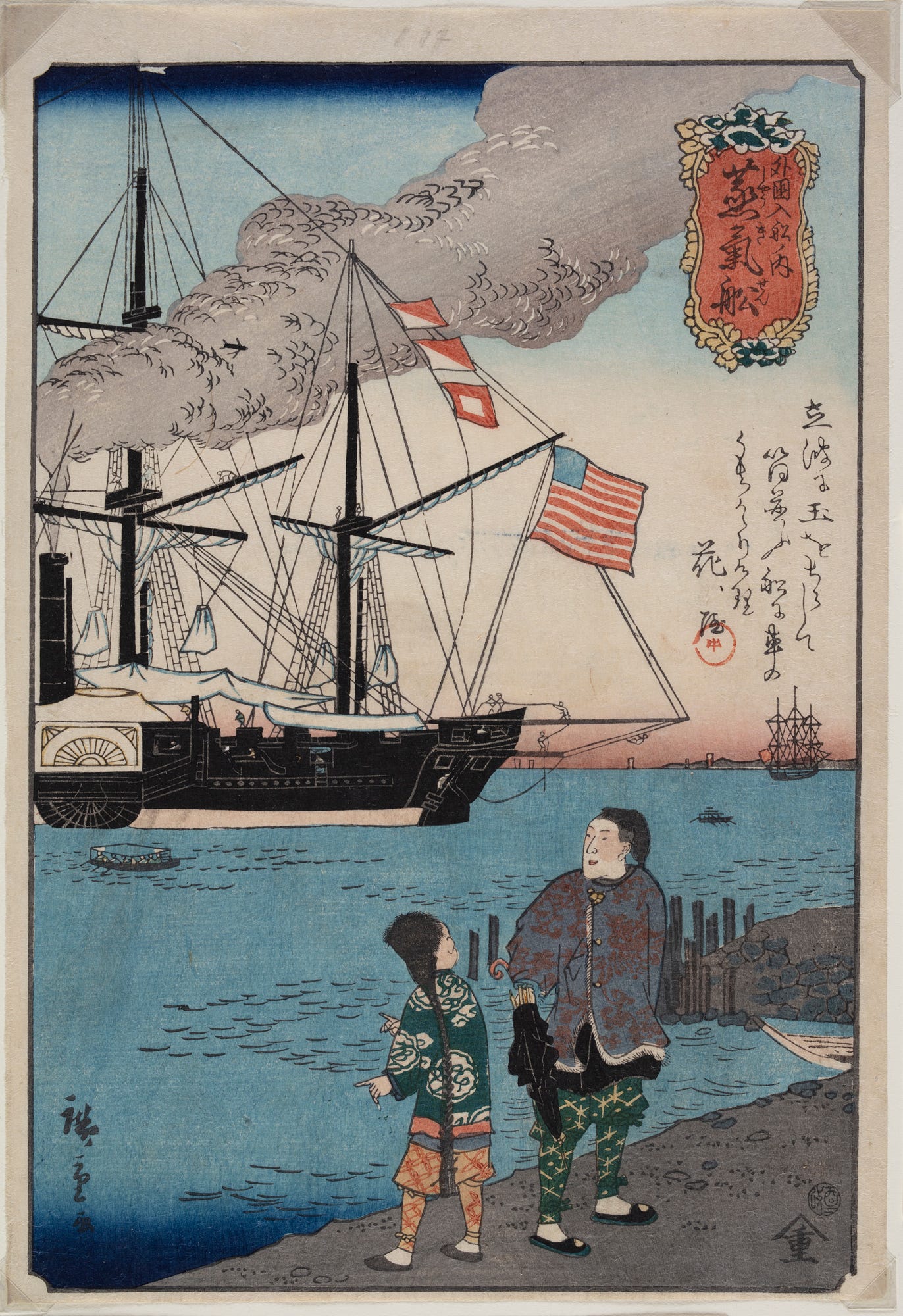Welcome to our weekly installment with excerpts from Cult of GT-R, my newest nonfiction book about the history and controversy of the Nissan Skyline GT-R, available now. Every Monday, I’ll post a short section from a different chapter, plus photos and commentary, to give you a taste of what’s in the book.
You can read the Chapter 1 excerpt here and our Chapter 2 excerpt here. To buy Cult of GT-R, click here for my website or find it at your favorite online retailer. Enjoy!
Cult of GT-R: Chapter 3 Excerpt

LOOKOUTS STATIONED along the Japanese coast could not believe their eyes. For more than 200 years, their country had been closed off in near-total isolation. The ruling class, known as the Tokugawa, had imposed a strict period of sakoku, or “closed country,” due to its distrust of the outside world. Long ago, Europeans had stormed ashore attempting to spread their religion. The Tokugawa sent them all away, particularly the Portuguese, which were derisively referred to as nanban-jin, or “southern barbarians.” For more than two centuries, Japan had expelled all visitors, keeping pace with the outside world by reading books imported by a small faction of Dutch people who were permitted to live on a man-made island in the Bay of Nagasaki. That way the Komo, or “red-hair,” were not technically touching Japanese soil.
But immediately, it was clear there was little to be done against these new foreigners. The lookouts stood aghast as a fleet of massive steam-powered ships, black as night and spewing thick clouds of smoke, churned through the ocean and advanced rapidly toward Japanese shores.
Each of the four ships was easily the largest vessel anyone on shore had ever seen. Japan had not yet advanced to engineering steam ships, and even the whaling boats that sometimes strayed too close to shore were dwarfed by comparison. In fact, next to the largest Japanese-made boats of the time, each of the steam ships, these “veritable castles,” was roughly 20 times bigger. And not only that: each black ship towed a mighty sailboat behind it, plowing along against the raging current. This was nothing less than a show of power.
Aboard the lead ship, a 257-foot frigate called the Susquehanna, stood Commodore Matthew C. Perry. At 57, Commodore Perry had risen to become an experienced officer in the United States Navy. He directed the fleet, at the behest of President Millard Fillmore, directly into the heart of Edo Bay, or modern-day Tokyo Bay. The Japanese had affixed floating signs in the water, warning all comers—in French —that they were entering forbidden territory. But Perry took no notice and blew straight past them. He positioned the ships so that they blocked access to the bay, preventing others from entering or leaving. And he turned the ships sideways, so lookouts on the coast could stare straight down the massive cannons pointed in their direction.
Perry carried a letter from President Fillmore that would alter the course of Japanese history. It requested that the country open its borders to engage in trade with the United States, granting the U.S. an exclusive partnership, as well as provide safe passage to American ships and whaling vessels. Perry and Fillmore both knew this was a tall order. Japan had made it clear that all foreigners were unwelcome—there were rumors about harsh treatment of shipwrecked sailors that washed up on Japanese land, and soldiers following a Tokugawa decree had previously fired upon Americans attempting to return Japanese sailors to their home country.
Even in the face of this, Perry was determined to succeed. He promised his superiors, “We will demand as a right, not solicit as a favor, those acts of courtesy due from one civilized nation to another.” He also believed whole-heartedly in American colonialism. Many were convinced Japan was sitting on vast reserves of untapped coal, a resource the young United States craved as a means to fuel its westward growth.
America had recently won possession of California in the Mexican-American War of 1846-48, and envisioned a new revenue source in building ports that could handle trans-Pacific trade. There was also the desire to introduce their God to the Japanese people, convinced that previous European colonizers had failed because the Japanese simply disliked Catholicism, not Christianity in general. (Unbeknownst to them, the Tokugawa had decreed the religion a capital offense in Japan.)
Perry came to shore and demanded to deliver the letter to the emperor. The Japanese were taken aback. His insistence that the message be viewed only by the emperor, or one of his princes, was simply not possible; Japan was ruled by the Tokugawa and its regional governors. The emperor was little more than a figurehead. The gaijin, or foreigners, were instructed to leave immediately, or else.
That was a bluff, and Perry knew it. He refused to turn back. Surprisingly, the maneuver seemed to impress the Japanese. Locals dubbed the American’s massive vessels the “black ships,” not for their darkened hulls, but for the smoke that belched skyward from their stacks. This was not the oversized sailboat that others had swanned in on. Through a translator, Navy officers said the commodore was “committed to delivering the message or dying in the attempt.”
In short, Perry was brash but formidable. He had arrived uninvited and unwelcome, aimed high-powered weapons at his hosts, and demanded they break centuries of tradition. Could it be possible, the Japanese wondered, that this was a partner worthy of their great nation?
Nearly a week after Perry’s ships steamed into Edo Bay, two of the emperor’s imperial princes arrived at the shore. American sailors delivered to them a rosewood chest containing letters from both President Fillmore and Perry, and that chest was then taken directly to the emperor, just as Perry had insisted. The job was done and a dynamic had been established. In his thorough modern retelling of the encounter, American historian George Feifer wrote that, the moment the Japanese accommodated Perry, it kicked off a “big brother little brother relationship” that persists to this day.
Perry stayed in the bay for three more days, just to show that he could, then turned and sailed away. The Americans needed to restock supplies, and the reprieve also allowed the Japanese time to process what just happened. Perry had not accomplished all of his goals on the first go, but his visit marked the most significant meeting between Japan and a foreign country in some 250 years, and he left a promise to return in six months for further discussions. When he came back, in February of 1854, it was with twice as many ships. Formal negotiations began on March 8th. Whether the Japanese were resistant or reluctant at first is unclear. What we know for sure is that Perry considered the result a victory. The treaty that resulted, the Convention of Kanagawa, was signed by both sides on March 31 under an American flag, then with only 31 stars, flown almost inconceivably on Japanese soil.

In that agreement, Japan promised to protect American castaways, and to open two ports for ships to safely station and load. The Japanese did achieve some moral victories. Critically, the agreement did not open the two countries to trade, one of Perry’s main objectives. Nor did the Japanese sign the treaty’s English-language copy, owing to a Tokugawa edict forbidding the signing of a document written in another language.
These conditions were hard-fought, but short-lived. A formal trade agreement arrived four years later, making the United States the first foreign nation in centuries to convince Japan to open its borders, its resources, and its society to the outside world. No single event has shaped the course of modern Japan more than the arrival of Commodore Perry, and the effects still resonate. By some reports, Perry remains “perhaps the most widely known foreign historic figure in Japan,” even today.
According to the New York Times, these days a typical junior high textbook in Japan devotes three lines of text to the attack on Pearl Harbor, and three full pages to Perry. This event that is scarcely mentioned in America, and practically never taught in schools, in many ways rules the collective psyche for Japanese people hundreds of years later. Feifer, the historian, wrote that the country still experiences deeply embedded humiliation, an “unconscious hatred,” over the event.
The name given for this national, internalized condition? Black ships trauma.
About This Chapter
America was on the verge of civil war in 1853 and 1854, relegating Perry’s arrival in Japan to a relative footnote in U.S. history. As a result, our country’s role in forcefully opening Japan to the rest of the world amounts to less than a blip on our national radar today. But to the Japanese, it remains deeply important.
During one meeting with a Japanese source, I mentioned in passing the effect Perry had on the country. “Ah yes,” they said. “The Black Ships.” It’s funny how one event that barely qualifies to be taught in U.S. schools can still affect others an ocean away after more than 150 years.
I knew I wanted to incorporate history into Cult of GT-R in order to separate it from other car books. But I didn’t know I would find such a direct line from U.S. involvement—or intrusion—during the 19th century to the story of the Skyline GT-R today. But as you learn later in the chapter, that connection becomes crystal clear.
Japan’s automotive industry, and Nissan in particular, was born of the conditions that the U.S. imposed on Japan. And their rise was a scorned nation’s attempt to recapture collective glory. More than any other car, the Skyline GT-R was a point of pride. It was a Japanese car for Japanese buyers. It was something to be kept at home. Something to help a nation heal.
The U.S. and Japan have been intertwined in myriad ways since Commodore Perry strolled into Edo Bay and made his demands. This is the cultural DNA I hoped would set Cult of GT-R apart, and offer readers a deeper understanding of the how and why behind the Skyline GT-R story. To me, it certainly explains a lot.
Link Central
In lieu of what I’ve been reading this week, I thought it’d be fun to highlight some nonfiction books that served as inspiration to me during the writing process. I consider these master works in narrative nonfiction and tried to live up to them as best I could:
A Perfect Red: Empire, Espionage, and the Quest for the Color of Desire by Amy Butler Greenfield
The Swerve: How the World Became Modern by Stephen Greenfield
Killers of the Flower Moon: The Osage Murders and the Birth of the FBI by David Grann
The Library Book by Susan Orlean
American Heiress: The Wild Saga of the Kidnapping, Crimes and Trial of Patty Hearst by Jeffrey Toobin
The Feud That Sparked the Renaissance: How Brunelleschi and Ghiberti Changed the Art World by Paul Robert Walker
Moneyball: The Art of Winning an Unfair Game by Michael Lewis
Dilla Time: The Life and Afterlife of J Dilla, the Hip-Hop Producer Who Reinvented Rhythm by Dan Charnas
(Full disclosure: As an affiliate of Bookshop.org, we earn a commission on purchases made through our shop.)
Have a great week!
Check out Carrara Media on Instagram, Twitter and Facebook and visit our store to order one of our many fine books and eBooks.




